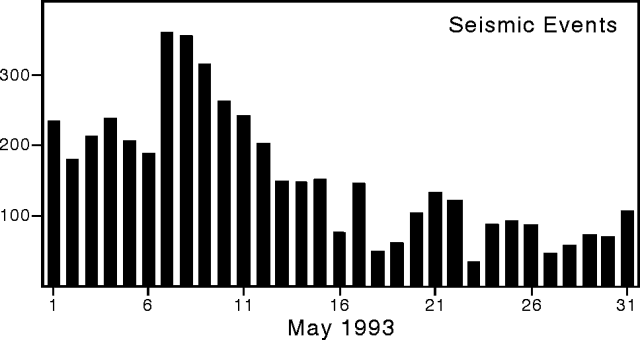Report on Poas (Costa Rica) — May 1993
Bulletin of the Global Volcanism Network, vol. 18, no. 5 (May 1993)
Managing Editor: Edward Venzke.
Poas (Costa Rica) Increased fumarolic activity; small phreatic events stopped by lake level rise
Please cite this report as:
Global Volcanism Program, 1993. Report on Poas (Costa Rica) (Venzke, E., ed.). Bulletin of the Global Volcanism Network, 18:5. Smithsonian Institution. https://doi.org/10.5479/si.GVP.BGVN199305-345040
Poas
Costa Rica
10.2°N, 84.233°W; summit elev. 2697 m
All times are local (unless otherwise noted)
Fumarolic activity increased during the first half of May as gas columns rose 500 m above the crater rim. Sulfur odors were reported by residents S, SW, and W of the summit. In the first half of May, bubbling ponds of mud and water in the NE and SE parts of the hot lake had temperatures up to 91°C. The lake was yellow-green with a maximum temperature of 71.5°C. Phreatic eruptions to heights of 1-2 m occurred from the center of the lake in early May, but stopped when the lake level rose 1 m following the start of the rainy season. The rise in lake level covered the small bubbling mud puddles. The temperature of the turquoise-green lake was 63°C in late May. Fumarolic activity, with strong jet-like sounds, continued in the N and SE parts of the lake. The temperature of the dome fumaroles in May was 80°C, similar to that measured in February. Plants in the area continue to be affected by local acidity.
Deformation measurements 16 April to 17 May indicated very slow changes. Deflation was <8.3 µrad along two leveling lines radial to the crater (1-1.8 km S). Distances across the crater showed no significant changes. A seismic station 2.7 km SW of the main crater recorded 4,700 low-frequency events (<2.5 Hz) in May, an average of 152/day. Seismicity for the month peaked on 7 May and slowly declined to a low on 23 May (figure 45). There were 21 middle-frequency events (2.5-3 Hz) recorded, with the highest daily total on 10 May. Volcanic tremor recorded 19 and 23 May had frequencies of 1.3-2.0 Hz, with amplitudes of 2-5 mm.
 |
Figure 45. Daily low-frequency seismicity recorded 2.7 km SW of the main crater of Poás, May 1993. Courtesy of OVSICORI. |
Geological Summary. The broad vegetated edifice of Poás, one of the most active volcanoes of Costa Rica, contains three craters along a N-S line. The frequently visited multi-hued summit crater lakes of the basaltic-to-dacitic volcano are easily accessible by vehicle from the nearby capital city of San José. A N-S-trending fissure cutting the complex stratovolcano extends to the lower N flank, where it has produced the Congo stratovolcano and several lake-filled maars. The southernmost of the two summit crater lakes, Botos, last erupted about 7,500 years ago. The more prominent geothermally heated northern lake, Laguna Caliente, is one of the world's most acidic natural lakes, with a pH of near zero. It has been the site of frequent phreatic and phreatomagmatic eruptions since an eruption was reported in 1828. Eruptions often include geyser-like ejections of crater-lake water.
Information Contacts: E. Fernández, J. Barquero, F. de Obaldía, T. Marino, R. Van Der Laat, V. Barboza, and R. Saenz, OVSICORI; G. Soto, ICE.

